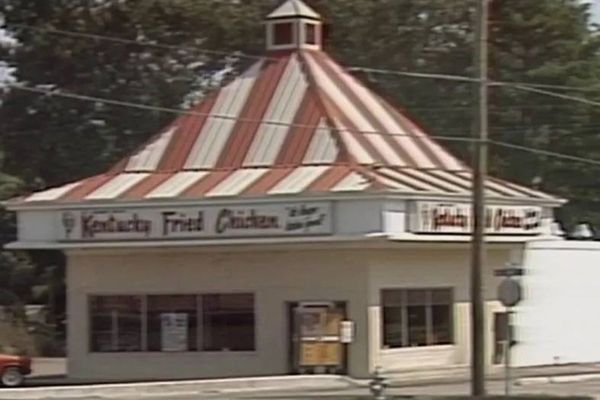
There has been much talk about our hunger for a “return to optimism”. Our world has been too real for too long, and we all just want a bit of shelter from the storm.
We look back in patronising nostalgia at Obama’s Hope poster in the same way we insist music hasn’t been real music since about 1986 (or since 1966, or since the Great American Songbook, or since Mozart, depending who you talk to).
Movie theatres are propped up by two monolith tent poles: DC’s umpteenth Superman and Marvel’s Fantastic Four reboot, both attempting a full factory reset of their flagship properties.
It offers a return to the originals – AKA, the “good old days”. But this isn’t so much a yearning for a new optimism as it is a resuscitation of an old one. The Fantastic Four is even set in a 1960s Jetsons-style alternate reality (the first comic was published in 1961).
Remember this? This is Things As They Should Be™.
The great irony in this regurgitation of old aesthetics is that, they themselves looked forward. The joy and optimism of the space age showcased the marvellous and fantastic possibilities of technology and science, before we knew that those same industries would slowly start choking our own atmosphere.
We want to go back to that time, when we could feel good about driving our big shiny bubble cars and tease our hair up guilt-free – without thinking about the ozone or whatever.
This perceived collective optimism was never real, of course. But now, after decades of doom storytelling and hope erosion, we want the dream back.
What’s happening in the culture is more than the good honest fun of theme park recreations, 1950s diners and old west camera filters. This is an earnest but somehow deeply sad defibrillation of dead worlds, built around a hollow craving that can never ever be filled.
We are birds constantly regurgitating and eating our own upchuck. Same flavour but different colour, different flavour but same chunks.
Its passion looks inspirational, but its sniff is grief. It works, but not quite — as fresh as microwaved leftovers.
It’s the cultural equivalent of Maga – the lie that there was some glorious past where things were flourishing and wholesome and if we can just get back there we’ll be on track again. But there never was that past. It’s a distortion of immature childhood memories and historical rewriting by big corporations.
This is the multiverse made real by an increasingly small cabal of conglomerates leveraging their various assets, stuffing each storytelling turducken full of old money-makers to reduce the risk in anything new. It’s not so much the multiverse as the IP-verse. Every brand everywhere all at once.
Over time this starts to feel like a photocopy of a photocopy. The AI boom is quite literally sampling and recycling things that already exist.
When I see a brand-new building proudly inspired by the art deco movement of 100 years ago, I wonder if the great deco designers knew way back then that they were on the blind precipice of the future, or were they recreating their own nostalgic past? I wonder, as typography and graphic design trends cycle through recreations of past “vintage” ideas, what the concept of “vintage” meant to people back when it was, to them, modern?
Having lost hope for the future, we have always looked back for comfort. We have to be cautious of the reasons why.
Why did Nazi aesthetics have such a fetish for ancient Rome? Why did Soviet culture idolise modern industrial style? Even in The Handmaid’s Tale’s Gilead, they revere the natural and organic by insisting on non-GM and high-fat foods. The world around us tells us a lot about our beliefs.
We are all potential victims of this ideological myth-making. It’s invisible but everywhere, and it’s difficult to tell if people in power aim to manufacture a world that matches their values or if it’s some kind of naturally developing, laissez-faire attraction.
We’re all dreaming of a better time from the past, since there is no future. We’ve stopped dreaming about building – now we dream of recreating.
It’s not recreating the actual thing that we want, it’s the yearning to recreate the feeling we had back then.
In my local city centre, I drive past heritage-protected sandstone buildings with the names of the original shopfronts still carved at the top. The mason etching that date in the rock was doing it for the future, so as time stretched on his mark would stay there, even for me now as I whip past the exact same building in a space shuttle machine he could never even dream of.
Imagine a shop front named something like, “Nolan and Sons Merchants, est. 1861.” And on the shop front awning below it, computer-printed on laminate in an deliberately old-timey font, “Buzz’d Cafe, est. 2025.”
Take a sledgehammer to the wall of this cafe. Pierce the membrane of lino wallpaper printed to look like rustic bricks and find sterile chalk-white plasterboard from the previous shop, which was itself once added to modernise and cover the rustic brick walls beneath.
You can find these rings of a tree in everything: generations on top of generations of us each trying to make our own existence matter and either cover or recover the ones before us.
So, do we seek comfort in the baby blanket of our past myths – or do we try to create our own new ones?
• Martin Ingle is a writer and film-maker







